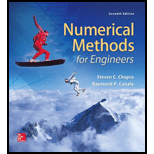
Use the Gauss-Seidel method (a) without relaxation and (b) with relaxation
(a)
To calculate: The solution of following system of equation with Gauss-Seidel method without relaxation to a tolerance of
Answer to Problem 12P
Solution:
Using Gauss-Seidel method four iterations are performed to get the values
Explanation of Solution
Given Information:
A system of equation:
With
Formula used:
(1) The values of
(2) Convergence can be checked using the criterion
For all i, where j and j- 1 are the present and previous iterations.
Calculation:
Consider the system of equation:
The sufficient condition for convergence is:
If the diagonal coefficient of each equations is greater than the sum of the absolute values of the other coefficients present in the equation. The systems where this condition holds are called diagonally dominant.
Thus, the firstarrange the equation so that theywill be diagonally dominant.
It can be written in the form:
Where,
First, solve the equations for its unknown and find the value of
For initial guess, assume
Thus, equation (1) becomes,
Substitute the value of
Now, substitute the calculated values of
For the second iteration, the same process is repeated with
The value of
Now, substitute the calculated values of
Now, the error can be computed as:
For the third iteration, the same process is repeated with
The value of
Now, substitute the calculated values of
Now, the error can be computed as:
For the fourth iteration, the same process is repeated with
The value of
Now, substitute the calculated values of
Now, the error can be computed as:
Thus, after four iterations the maximum error is 0.13% which is less than
(b)
To calculate: The solution of following system of equation with Gauss-Seidel method withrelaxation
Answer to Problem 12P
Solution:
Using Gauss-Seidel method four iterations are performed with relaxation
Explanation of Solution
Given Information:
A system of equation:
With relaxation
Formula used:
(1) The values of
(2) Relaxation:
Where
(3) Convergence can be checked using the criterion
For all i, where j and j- 1 are the present and previous iterations.
Calculation:
Consider the system of equation:
If the diagonal coefficient of each equations is greater than the sum of the absolute values of the other coefficients present in the equation. The systems where this condition holds are called diagonally dominant.
Thus, the first arrange the equation so that they will be diagonally dominant.
It can be written in the form:
Where,
First, solve the equations for its unknown and find the value of
For initial guess, assume
Thus, equation (1) becomes,
Relaxation yields:
Substitute the value of
Relaxation yields:
Now, substitute the calculated values of
Relaxation yields:
For the second iteration, the same process is repeated with
Relaxation yields:
The value of
Relaxation yields:
Now, substitute the calculated values of
Relaxation yields:
Now, the error can be computed as:
For the third iteration, the same process is repeated with
Relaxation yields:
The value of
Relaxation yields:
Now, substitute the calculated values of
Relaxation yields:
Now, the error can be computed as:
Also,
Thus, after four iterations the maximum error is 3.71% which is less than
Want to see more full solutions like this?
Chapter 11 Solutions
Numerical Methods for Engineers
Additional Math Textbook Solutions
Basic Technical Mathematics
Fundamentals of Differential Equations (9th Edition)
Advanced Engineering Mathematics
Graphical Approach To College Algebra
Intro Stats, Books a la Carte Edition (5th Edition)
 Advanced Engineering MathematicsAdvanced MathISBN:9780470458365Author:Erwin KreyszigPublisher:Wiley, John & Sons, Incorporated
Advanced Engineering MathematicsAdvanced MathISBN:9780470458365Author:Erwin KreyszigPublisher:Wiley, John & Sons, Incorporated Numerical Methods for EngineersAdvanced MathISBN:9780073397924Author:Steven C. Chapra Dr., Raymond P. CanalePublisher:McGraw-Hill Education
Numerical Methods for EngineersAdvanced MathISBN:9780073397924Author:Steven C. Chapra Dr., Raymond P. CanalePublisher:McGraw-Hill Education Introductory Mathematics for Engineering Applicat...Advanced MathISBN:9781118141809Author:Nathan KlingbeilPublisher:WILEY
Introductory Mathematics for Engineering Applicat...Advanced MathISBN:9781118141809Author:Nathan KlingbeilPublisher:WILEY Mathematics For Machine TechnologyAdvanced MathISBN:9781337798310Author:Peterson, John.Publisher:Cengage Learning,
Mathematics For Machine TechnologyAdvanced MathISBN:9781337798310Author:Peterson, John.Publisher:Cengage Learning,






